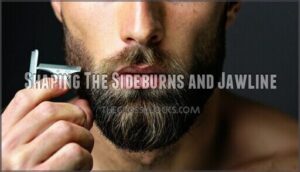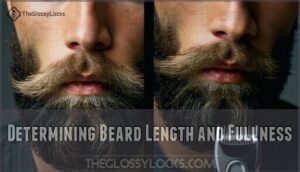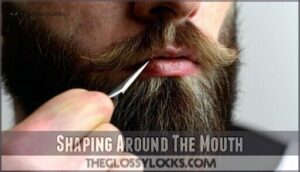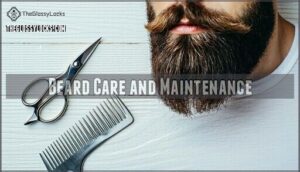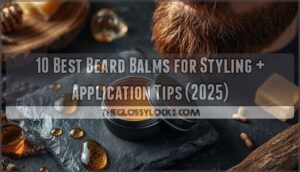This site is supported by our readers. We may earn a commission, at no cost to you, if you purchase through links.
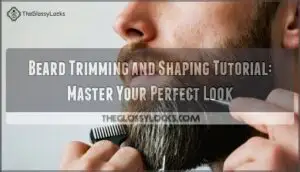
Choose a style that complements your face shape—oval faces handle most styles, while round faces need angular cuts for definition. Use precision trimmers for clean lines and clippers for gradual tapering.
Start by defining your neckline above the Adam’s apple, then shape the jawline and cheek line. Trim gradually, checking symmetry frequently. Regular maintenance keeps your shape sharp and prevents major corrections. The right tools and technique transform any beard into a confidence-boosting statement.
Table Of Contents
- Key Takeaways
- Preparing Your Beard for Shaping
- Choosing The Right Beard Style
- Trimming Basics and Tools
- Mastering The Neckline
- Shaping The Sideburns and Jawline
- Shaping The Cheek Line
- Determining Beard Length and Fullness
- Shaping Around The Mouth
- Beard Care and Maintenance
- Finding Your Perfect Beard Shape
- Frequently Asked Questions (FAQs)
- How do you shape a beard trimmer?
- How do I trim my beard according to my face shape?
- How often should you trim and shape your beard?
- How do you trim and train a beard?
- How often should I trim my beard?
- Whats the best way to handle ingrown hairs?
- How do I fix an uneven beard?
- Can I shape my beard at home safely?
- How does diet impact beard growth?
- How often should I replace beard trimming tools?
- Conclusion
Key Takeaways
- Start with proper prep work – wash your beard with quality shampoo, dry it thoroughly, and apply beard oil to soften the hair before you begin trimming
- Choose your style based on face shape – oval faces can handle most styles, while round faces need angular cuts for definition and square faces benefit from softer, rounded edges
- Master the fundamentals first – define your neckline above the Adam’s apple, shape clean cheek lines with a precision trimmer, and always trim gradually while checking symmetry frequently
- Maintain your look with regular upkeep – trim every 2-4 weeks to keep your shape sharp, use quality tools, and apply beard oil daily to prevent major corrections down the road
Preparing Your Beard for Shaping
Before you start shaping your beard, you need to prepare it properly for the best results. Clean your beard with beard shampoo, dry it thoroughly, then apply beard oil to soften the hair and make trimming easier.
Washing and Drying Your Beard
Start with lukewarm water—hot temperatures strip your beard’s natural oils faster than you’d think. Getting your beard prepped means washing smartly, not obsessively.
Here’s your washing roadmap:
- Washing Frequency: Stick to 2-3 times weekly to avoid product buildup while preserving natural moisture
- Shampoo Types: Choose dedicated beard shampoo over regular hair products for gentler cleansing
- Drying Techniques: Pat with a beard towel instead of rubbing to prevent frizz and breakage
- Water Temperature: Use cool-to-warm water to maintain your beard’s protective oils
Your beard wash frequency matters more than intensity. Proper preparation creates the foundation for precise trimming.
Applying Beard Oil for Softening
Perfect beard oil application transforms coarse whiskers into manageable strands ready for precise trimming. Choose oils with jojoba or argan—these ingredients offer superior Oil Absorption Rate and nourishing Ingredient Benefits.
Quality beard oil with jojoba or argan transforms coarse whiskers into soft, manageable strands ready for precision trimming
Apply 3-4 drops daily for ideal Oil Application Frequency. Warm the oil between your palms, then work it through damp beard hair from roots to tips. This beard care ritual softens tough hairs, making your shaping tutorial efforts more effective.
Pre-shave oils offer hydration and softening benefits. Monitor your Softness Level Monitoring weekly—adjust application as needed.
Different Oil Brand Comparison reveals varying results, so experiment to find your perfect match for successful beard trimming.
Choosing The Right Beard Style
Choosing the right beard style isn’t just about following trends—it’s about finding what works best with your unique face shape and personal style.
Your facial structure will determine which beard styles enhance your features and which ones work against them.
Your face is the blueprint—your beard is the architecture that brings it to life
Considering Face Shape
Your beard’s success hinges on understanding your facial proportions. Professional barbers identify face shape as the most important factor in design recommendations, with 65% prioritizing this element for ideal beard symmetry.
Oval face owners hit the jackpot—you can experiment with most style adaptations since your balanced proportions suit various looks. Round face guys need shape variations that add vertical length through fuller chin coverage while keeping sides trimmed. Square face types should soften sharp angles with rounded beard edges rather than boxed corners. Triangle face shapes require strategic balancing—reduce chin volume while maintaining fuller sides to counteract your prominent jawline.
Your personal preferences matter, but working with your natural structure creates harmony. These targeted approaches enhance your features rather than fighting them, delivering that confident look you’re after.
Complementing Facial Features and Personal Style
Your Beard Personality shines through your chosen facial hair styles. Once you’ve determined your face shape, it’s time to match your beard style with your unique features and lifestyle.
Your facial features play a key role in choosing a beard style. Strong jawlines pair well with shorter beards that don’t hide your natural structure. Softer features benefit from fuller styles that add definition. Consider how your beard works with your hairstyle too—hairstyle harmony creates a polished look that flows from top to bottom.
Your personal style matters just as much. Here’s what to keep in mind:
- Professional requirements: Some workplaces need trimmer styles, while creative fields allow more freedom.
- Lifestyle demands: Active guys might prefer low-maintenance cuts that won’t interfere with sports or hobbies.
Think about tattoo integration if you have neck or face ink—your beard can complement or frame your artwork. Style consistency across your entire look shows attention to detail. Remember, occasion appropriateness means your facial hair should match the moment, whether that’s a board meeting or weekend barbecue. To maintain a sharp look, regular trimming is essential.
Trimming Basics and Tools
Beyond choosing your ideal beard style, mastering trimming basics requires the right arsenal. Your beard trimmer serves as the foundation—invest in quality with adjustable guard lengths for consistent results.
scissor techniques
Comb selection affects cut quality
Trimmer maintenance keeps blades sharp and extends tool life. Clean after each use and oil moving parts regularly. Tool sterilization prevents skin irritation and infection—alcohol wipes work perfectly. To prevent irritation, always trim following the beard’s natural direction.
Your beard deserves professional treatment. Quality tools transform amateur attempts into polished results. Remember: cheap tools create expensive problems, while proper equipment delivers the control you need for consistent, impressive results every time.
Mastering The Neckline
Getting your neckline right can make or break your entire beard look. You’ll want to locate your Adam’s apple first, then trim about two fingers below it using a straight razor for the cleanest lines.
Locating The Adam’s Apple
Having the right beard trimming and shaping tutorial tools sets you up for success, but proper neckline placement starts with one key landmark: your Adam’s apple. This small but important anatomical feature serves as your guide for creating a balanced beard neckline that won’t leave you looking unkempt or over-trimmed.
Finding your Adam’s apple isn’t rocket science, but individual variation means some guys need to work a bit harder than others. Here’s your step-by-step approach:
- Swallow slowly: Feel that prominent bump move up and down – that’s your target.
- Use proper lighting: Position yourself in front of a well-lit mirror for clear visibility.
- Tilt your head back slightly: This helps reveal Adam’s Apple prominence in different neck types.
- Feel with fingertips: Close your eyes and locate it by touch for better spatial awareness.
Once you’ve pinpointed this reference point, you’re ready to establish your neckline with confidence. Remember, avoiding mistakes starts with knowing exactly where your natural anatomy sits before making any trimming guidance decisions.
Trimming With a Straight Edge Razor
Now that you’ve pinpointed your Adam’s apple, it’s time for the straight edge razor work. Start by preparing your skin with warm water and quality shaving cream—proper skin prep prevents irritation and cuts. Hold your razor at a 20-30 degree angle against your neck. Use short, controlled strokes moving upward from the neckline reference point. You can find a quality razor selection online for superior results.
Straight Razor Technique Essentials
| Step | Action | Key Point |
|---|---|---|
| Preparation | Apply shaving cream, stretch skin | Creates smooth surface |
| Stroke Technique | Short upward movements | Maintains control and precision |
| Razor Maintenance | Keep blade sharp, clean between strokes | Guarantees clean cuts |
Always stretch your skin taut with your free hand—this cut-avoiding strategy works every time. These trimming techniques require patience, so don’t rush. Clean your blade frequently during trimming to maintain effectiveness. Master these beard shaping techniques and your straight edge razor will become your best trimming tool.
Shaping The Sideburns and Jawline
Now that you’ve perfected your neckline, it’s time to focus on the sideburns and jawline for a sharp, polished look. **These areas frame your face and create the structure that transforms your beard from messy to masterful.
Tapering With Clippers or a Comb
Now that your neckline’s sharp, let’s perfect those sideburns with proper tapering techniques. Clipper guards are your best friend here—start with a higher guard like a 4 for bulk removal, then step down gradually. This creates that gradual taper you’re after without harsh lines.
Comb techniques work wonders too. Hold your comb perpendicular to the jawline, lift the hair, and trim what sticks out. This blending lengths method gives you precise control over each section.
The secret sauce? Work with the grain, not against it. Avoiding lines means taking your time—remove small amounts gradually rather than going aggressive. Your clippers should follow your beard’s natural growth pattern. For a consistently sharp look, consider weekly tapering routines.
Remember, trimming basics always apply: symmetry is everything. Work both sides equally to prevent that lopsided look nobody wants.
Defining The Jawline
With your sideburns perfectly tapered, you’re ready to define your jawline for that sharp, masculine look. This step creates the foundation for proper beard fullness and jawline symmetry.
Start by following your natural jaw curve with a precision trimmer or razor. Move slowly from your sideburns downward, maintaining consistent pressure. Don’t rush this process—one slip can create uneven sharp angles that throw off your entire look.
Here’s what proper jawline definition gives you:
- Confidence boost from a clean, structured appearance
- Enhanced facial structure that complements your natural features
- Professional polish that commands respect in any setting
Keep your movements steady and deliberate. If you’re dealing with a double chin, focus on softening lines rather than creating harsh edges. The goal isn’t perfection—it’s enhancement of your natural bone structure through smart trimming techniques.
Shaping The Cheek Line
Shaping your cheek line properly separates a professional-looking beard from an unkempt mess. You’ll need steady hands and the right technique to create clean, natural-looking lines that enhance your facial structure.
Using a Precision Trimmer
Selecting the right precision trimmer transforms your beard trimming and shaping tutorial from frustrating to flawless. Your trimmer blade determines everything, so invest wisely.
| Feature | Budget Option | Premium Choice |
|---|---|---|
| Precision Guards | Basic 3-4 settings | 10+ adjustable lengths |
| Battery Life | 30-45 minutes | 90+ minutes runtime |
| Blade Quality | Standard steel | Titanium-coated precision |
Choose corded vs. cordless based on your routine. Corded models offer consistent power, while cordless provides freedom of movement.
Trimmer maintenance keeps blades sharp and prevents skin irritation. Clean after each use and oil monthly.
Start with longer precision guards when you adjust with a beard trimmer. Work gradually shorter until you find your sweet spot. Test different trimming techniques on small areas first.
Quality precision guards create even lines without tugging. Replace dull blades immediately—they cause more harm than help. Finding the right beard grooming tools is essential for achieving a well-maintained beard.
Creating a Natural Definition
Precision creates the foundation for natural cheeklines that enhance your facial structure. When shaping the beard around your cheek area, you’ll want to work with your natural growth patterns rather than against them. The key to mastering this beard trimming and shaping tutorial step lies in creating subtle definition without harsh edges. Start by identifying where your cheek hair naturally tapers off, then enhance that line rather than forcing an unnatural boundary.
Here’s your roadmap for achieving organic beardshape:
- Follow the imaginary line from your ear’s top to your mouth’s corner for natural cheeklines
- Use light, upward strokes with your trimmer to avoid overcutting
- Check both sides frequently to maintain symmetry
For trimming techniques that deliver professional results, work in good lighting and take your time. The goal isn’t razor-sharp lines but rather soft necklines and blended sideburns that flow naturally into your beard.
Remember, lining up cheeks is about enhancement, not reconstruction. Your natural definition already exists – you’re simply refining it for a polished appearance that complements your subtle jawlines.
Determining Beard Length and Fullness
Getting the right beard length and fullness is where your vision meets reality. You’ll need to work with your natural growth patterns while using your trimmer’s adjustable guards to create the exact density you want.
Adjusting With a Beard Trimmer
After establishing your cheek line, grab your beard trimmer and set the adjustable settings to a longer guard settings first. You can always trim shorter, but you can’t add hair back. Start with trimming angles that follow your face’s natural contours, working gradually to your desired length.
For a patchy beard, use longer settings to create fullness. Keep your precision trimmer clean for superior performance—proper trimmer maintenance prevents pulling and avoiding irritation.
Move the trimmer blade steadily in one direction, checking both sides frequently for evenness. This beard trimming and shaping tutorial approach guarantees controlled results without overcutting mistakes.
Maintaining The Desired Shape
Once you’ve adjusted your beard length, consistent trimming becomes your secret weapon for maintaining that polished look. Think of beard shaping as an ongoing conversation with your facial hair—it’s not a one-and-done deal.
Regular trimming every two to three weeks keeps everything in check. Focus on flyaway management by using quality trimming basics tools to catch stray hairs before they ruin your silhouette. Pay special attention to shape refinement around your jawline and cheekbones.
Don’t forget about seasonal adjustments—your beard might need different approaches as weather changes. Summer calls for lighter maintenance, while winter might require more intensive care. Style adaptations help you evolve your look without starting from scratch. The key to maintaining the desired shape lies in small, frequent touch-ups rather than dramatic overhauls.
Shaping Around The Mouth
The mouth area requires careful attention since it’s the most visible part of your beard and affects how clean your overall look appears. You’ll need to trim the goatee area precisely and tame any stubborn hairs that stick out around your lips.
Trimming The Goatee Area
When trimming your goatee area, start by combing the hair downward to see its natural fall. Use your precision trimmer to define the goatee shape, working from the outer edges toward the center. For goatee length, begin longer than your target—you can always trim more.
Goatee styles vary, but maintaining clean lines is key. If you’re dealing with a patchy goatee, keep it shorter to create uniformity. Focus on defining shape by following your natural lip line.
Styling tips include using steady, controlled movements and checking symmetry frequently. Remember, maintaining length requires regular touch-ups to keep your look sharp.
Managing Flyaway Hairs
After trimming the goatee area, you’ll notice some rogue hairs sticking out around your mouth. Managing flyaway hairs requires the right approach and Product Selection.
Here’s your game plan for flyaway hairs control:
- Brush Techniques – Use a boar bristle beard brush to train hairs downward and distribute natural oils
- Balm Application – Apply a small amount of beard balm while hair is slightly damp for better hold
- Taming Sprays – Light misting with specialized beard spray helps with stubborn pieces
- Humidity Control – Keep bathroom fan running during shaping to prevent moisture-induced chaos
Start brushing from the center outward, working the balm through with your fingers. For particularly stubborn areas, a tiny amount of hairspray works, but don’t overdo it. The key is layering your products – brush first, then balm, finishing with spray if needed. This systematic approach keeps those pesky flyaways in check while maintaining a natural look that doesn’t scream "product overload.
Beard Care and Maintenance
Once you’ve mastered the shaping techniques, maintaining your beard becomes your daily priority. Consistent care prevents your hard work from falling apart and keeps your facial hair looking sharp and healthy.
Regular Trimming and Shaping
After you’ve mastered the goatee area, maintaining your beard’s shape becomes your ongoing mission. Regular trimming and shaping keeps your facial hair looking sharp and professional instead of wild and unkempt.
Consistent grooming isn’t just about looking good—it’s about feeling confident every day. Most guys find that weekly sessions work best for shape maintenance, but your trimming frequency depends on how fast your hair grows.
Here’s your game plan for staying on top of your beard game:
- Track your growth patterns to determine the perfect trimming frequency for your facial hair
- Invest in quality styling products like beard balms and waxes for better control
- Master flyaway control techniques using a boar bristle brush and light styling products
- Stick to your routine because consistent grooming prevents major shape corrections later
Remember, a well-maintained beard doesn’t happen by accident. It’s the result of regular attention and the right shaping tutorial techniques applied consistently over time.
Using Beard Oil for Conditioning
Quality beard oil transforms your facial hair from rough to remarkably smooth. Choose oils with proven Oil Ingredients like jojoba, argan, or sweet almond—each offers unique Oil Benefits for both hair and underlying skin. Consistent use of beard oil can also help in reducing itchiness and beardruff.
| Oil Type | Primary Benefit | Best For |
|---|---|---|
| Jojoba | Skin Hydration | Sensitive skin |
| Argan | Softening | Coarse beards |
| Sweet Almond | Shine enhancement | All beard types |
Your Application Frequency matters: use 3-5 drops daily after showering when hair’s still slightly damp. Work the oil through your beard using your fingertips, ensuring even distribution from roots to tips. Scent Selection affects your daily experience—choose wisely. Consistent beard care with quality oil prevents the dreaded "porcupine effect" while supporting healthy beard maintenance between trimming sessions.
Finding Your Perfect Beard Shape
Finding the right beard style for your face shape transforms your entire look from average to exceptional. You’ll discover which styles complement your unique features and create the balanced appearance that suits you best.
Oval Faces and Beard Styles
Lucky you — oval faces are the golden ticket of beard styling! Your balanced proportions mean you can experiment freely without worrying about correcting facial features.
Popular oval face beard styles include:
- Classic full beards for timeless appeal and maximum style versatility
- Short boxed beards offering professional definition with manageable maintenance needs
- Heavy stubble providing rugged charm with minimal upkeep requirements
Men with this face shape often find that balanced beard styles enhance their features. Celebrity inspiration from Jake Gyllenhaal and Idris Elba proves experimentation tips work beautifully on oval faces.
Round or Heart-Shaped Faces and Beard Styles
Round or heart-shaped faces benefit from angular styles that create chin definition and visual length. Focus on beard fullness at the chin while keeping sides shorter – this beard trimming technique elongates your face’s appearance.
Pointed styles like Van Dyke or Ducktail work well for round face shapes, while Full Chin Beards add strategic volume control for heart face types. Avoid bushy sideburns that add width.
Try style experimentation with different lengths, but maintain clean necklines and sharp cheek lines. This shaping tutorial approach transforms round or heartshaped faces by creating angular definition where you need it most.
Square Faces and Beard Styles
If you’ve got a square face, you’re working with strong jawline definition that needs the right approach. Your angular styles can either enhance or soften those prominent features. Square face beards work best when you balance those sharp angles. Focus on chin emphasis while keeping sides shorter. Structured beards with rounded edges soften harsh lines better than geometric cuts. Volume control is key—avoid adding width at your already-strong jaw.
This beard trimming and shaping tutorial for square faces centers on creating harmony. Styles include:
- Goatee styles that draw attention downward and elongate your face shape
- Rounded full beards trimmed at 12-14mm with soft graduation at the jaw
- Stubble beards kept at 3-4mm, focusing growth on the chin area
- Faded beard styles that blend thick hair with gradual shifts near ears
- Ducktail beards pointed at the chin to add vertical length and definition
Triangle Faces and Beard Styles
Triangle faces need careful style adaptations to balance your prominent jawline. Your wider jaw benefits from volume control techniques that add fullness to your cheeks while keeping chin definition subtle.
Try these beard trimming approaches for your triangle face:
- Full beard with tapered sides: Creates jawline emphasis without overwhelming your features
- Beardstache combo: Heavy mustache styles paired with a short beard draw attention upward
- Heavy stubble: Softens angular lines while maintaining masculine appeal
- Circle beard: Focuses on chin definition without widening your jaw
This shaping tutorial helps you work with your natural face shape instead of against it.
Frequently Asked Questions (FAQs)
How do you shape a beard trimmer?
You can’t actually "shape" a beard trimmer itself – it’s the tool that shapes your beard. Choose a quality trimmer with adjustable guards, then use it to define your cheekline, neckline, and overall beard contours for your desired style.
How do I trim my beard according to my face shape?
Looking to master the art of face-flattering facial hair? Triangle faces need full mustaches with shorter beards to balance strong jaws, while oval faces can experiment with virtually any beard style that suits your personality.
How often should you trim and shape your beard?
You should trim your beard every 2-4 weeks to maintain its shape and fullness. Weekly touch-ups help keep lines crisp, while daily oil application preserves health and manageability.
How do you trim and train a beard?
You’ll master beard training by washing, applying oil, and combing daily. Trim every 2-4 weeks with quality clippers, defining cheek lines and necklines carefully. Brush regularly to distribute oils and train growth patterns downward.
How often should I trim my beard?
Trim your beard every 2-4 weeks to maintain its shape and fullness. Weekly touch-ups help control length for most styles, while daily beard oil keeps everything healthy and manageable.
Whats the best way to handle ingrown hairs?
Like medieval barbers treating ailments with crude tools, you’ll need modern precision.
Exfoliate gently with a soft brush, apply warm compresses, and use salicylic acid treatments.
Don’t pick or dig—let proper skincare dissolve the blockage naturally.
How do I fix an uneven beard?
Start by identifying uneven areas using a beard comb and good lighting. Use precision clippers with guards to gradually even out longer sections. Work slowly, checking symmetry frequently from multiple angles.
Can I shape my beard at home safely?
You’ll transform into a grooming guru with the right tools and patience. **Use quality clippers, precision trimmer, and sharp scissors.
**
Start conservatively—you can always trim more, but you can’t put hair back. **Practice makes perfect, so don’t rush the process.
How does diet impact beard growth?
Your diet directly fuels beard growth through protein, vitamins, and minerals. Eat lean meats, eggs, nuts, and leafy greens.
Biotin, zinc, and vitamin D boost hair follicles, while proper hydration keeps follicles healthy.
How often should I replace beard trimming tools?
Your trusty trimmer won’t last forever—replace blades every 6-12 months depending on usage frequency. Quality clippers need blade replacement annually, while precision trimmers require attention when they start pulling hair instead of cutting cleanly.
Conclusion
Ironically, most men spend more time perfecting their video game avatars than mastering this beard trimming and shaping tutorial—yet your real face deserves the same attention. You’ve learned the fundamentals of preparation, tool selection, and precise techniques for creating clean lines.
Remember that practice makes perfect, and even barbers took years to master their craft. Start with conservative trims, maintain regular upkeep schedules, and don’t rush the process.
Your beard reflects your personal style and attention to detail, so invest the time to get it right.
- https://www.ripeinsurance.co.uk/small-business/hair-and-beauty-insurance/barber-insurance/
- https://stylecraftus.com/precision-saber-full-metal-body-digital-brushless-motor-cordless-hair-trimmer-black.html
- https://badassbeardcare.com/collections/brushes
- https://my.clevelandclinic.org/health/body/24656-adams-apple
- https://www.beards.org/grooming.php




